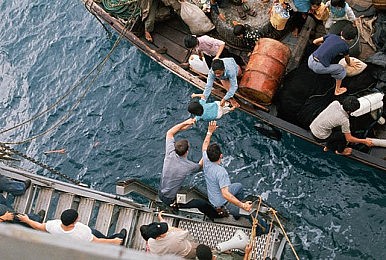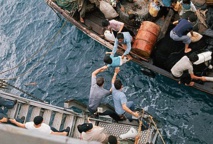According to the UN, the world number of refugees every year becomes greater every year (according to the latest data, the number of refugees and displaced persons has reached 60 million). Over the last year, this figure increased by 8.3 million. Humanitarian organizations lack resources to assist refugees and the EU's attempts to use the quota system works partially (it supported by only half of the countries - members of the European Union).
The idea of refugees’ resettlement in Kyrgyzstan and neighboring countries is not new. A couple of months ago it was suggested by the British Lord Desai. Speaking in parliament, he said that the United Nations should take resettlement of refugees from Syria and other Middle Eastern countries in Central Asia. Desai then referred to the fact that population density in Central Asia is much lower than in Europe, and the locals are culturally similar to migrants from the Middle East as they practice "the same religion", that is, Islam.
In itself, the proposal seemed superficial. The offer taken into account neither any specific authoritarian regimes in Central Asia, nor their tendency to isolation, nor the development level of their economies. Density of the population - without any additional factors - gives a very schematic representation of a country: the biggest part of Turkmenistan, for example, is desert, and the area suitable for agriculture is estimated at about 3% of the territory. Finally, local authorities themselves regard the offers differently.
Kyrgyzstan
The population density in Kyrgyzstan is relatively small - about 30 people per square kilometer. It is comparable to, for example, Latvia or Estonia. Because of the mountainous terrain, the population is distributed unevenly. For example, the largest region of Kyrgyzstan is 70% covered with mountains. The population density in the region is only about six people per square kilometer.
Taking into account assessments of the IMF, Kyrgyzstan is one of the poorest former Soviet countries by GDP per capita. Average wages level there, according to 2014 data, remains one of the lowest in CIS. At the same time, however, the republic is a leader among the Central Asian countries for "Happy Planet Index" (HPI, a rating, reflecting well-being of people, life and environment).
Kyrgyzstan has joined the international agreements concerning refugees - in particular, the UN Convention of 1951. The country has a law "On Refugees", which guarantees them a certain social support - for example, support in placement of children in refugee schools, although there is no benefits payments. Those, who received refuge, have right to get medical insurance – it is concern of United Nations High Commissioner for Refugees.
A large influx of refugees in Kyrgyzstan took place in the 1990s, during the civil war in Tajikistan. About 20 thousand people came from there - about half of them settled in Kyrgyzstan and received citizenship, while others returned to their homeland. Currently, according to official data, there is not much of refugees received an appropriate status in the country - least than two hundred people (mostly citizens of Afghanistan and Syria), and about 160 - asylum seekers (including several dozen of Ukrainians).
However, Bishkek refused to accept refugees from Australia. The Ministry of Labour and Migration, according to local press reports, said that the idea is not even considered, making it clear that Australia should deal with migrants by their own. Former Head of the Working Group on Migration Aigul Ryskulova suggested that the Kyrgyz authorities discussed the proposal, but considered it unrealistic (in her words, "our country is simply not ready for this - neither socially nor economically"). However, as suggested by the former Kyrgyz ombudsman Tursunbek Akun if Kyrgyzstan is pushed on international level, they may have to accept the offer.
Kazakhstan
Average population density in Kazakhstan is small - about six people per square kilometer. The most populous region is the South-Kazakhstan - there are around 23.5 people per square kilometer.
Kazakhstan is the most economically prosperous of Central Asian countries. In the ranking of the IMF estimates of GDP per capita (for 2014), the country is only slightly behind Russia. In HPI, Kazakhstan showed the lowest result in the region.
As of mid-2015, Kazakhstan hosted about 630 refugees. Most of them came from Afghanistan. Over the past two years, about 90 people from Ukraine and dozens of refugees from Syria applied for asylum. Refugee Act guarantees them freedom of labor, legal protection and medical care.
In general, as noted by the UNHCR representative Bernard Doyle, Kazakhstan is a favorable country for refugees, even though they are experiencing difficulties in finding jobs there. The latter circumstance was pointed in US State Department’s Report on Human Rights in 2014. Because of their special status (refugees are offered temporary residence permits, which must be updated annually), many refugees live in Kazakhstan for 10-20 years, but cannot get a job and take up Kazakh citizenship.
Commenting on the proposals for refugees resettlement, the government of Kazakhstan declared that they are willing to accept a certain amount. However, they expressed confidence that the country is not threatened with an influx of immigrants. Geographically, Kazakhstan removed enough from Syria and Afghanistan. Still, UNHCR believes that the country could receive more refugees.
Tajikistan
Average population density in Tajikistan - about 58 people per square kilometer. More than 90% of the territory is covered by mountains, inhabited patchy. For example, the Gorno-Badakhshan region has only three people per square kilometer, while Khatlon - more than 120.
In the ranking of the IMF estimates of GDP per capita, Tajikistan was the least economically prosperous country of the former USSR. According to the CIS Statistical Committee in 2014, the average salary there was the lowest in the Commonwealth countries. The country’s level of poverty is around 30%. In many ways, it is held back by money that migrant workers send to their families from abroad. Total number of those who left Tajikistan for work (mainly to Russia) is believed to be more than a million people.
Tajikistan, when compared with other Central Asian countries, accounts for most of the refugees from Afghanistan. Hundreds of persons are reported to arrive in the post-Soviet republic every year. Some of them stay, others try to get to Europe and the United States. Last year, there were about 4.5 thousand people in Tajikistan. They live rather difficult, many cannot find job.
Formally, the law on refugees, acting in Tajikistan, guarantees refugees the right to health care, employment, as well as "financial aid in the manner determined by the Government." In practice, getting asylum in Tajikistan has become more difficult in recent years - as was noted in one of reports, "the budget for this (social support for refugees) is not calculated, so officials are in no hurry to determine the migrants’ status." The US State Department’s report for 2014 indicated that the first half of the year, Tajik authorities satisfied only 5% of requests for asylum - compared with 60% a year earlier.
Migration crisis in Europe with influx of refugees from Syria and other countries also affected Tajikistan. A couple of months ago it became known that the United Nations Programme on the resettlement of Afghan refugees from Tajikistan to third countries has been suspended. Prior to that, about a thousand people were sent to Canada, European countries and the United States under the program since 2003.
Turkmenistan
Average density of Turkmenistan’s population is about 11 people per square kilometer. The main part of the country is covered by the Karakum Desert. The density is higher in populated areas - 50 people per square kilometer.
In the ranking of the IMF estimates of GDP per capita, Turkmenistan is ranked second after Kazakhstan among the Central Asian countries. By HPI, the country is second from the end, with about 39 points - 10 less than Kyrgyzstan. In 2012, the country fell into "poverty index" of Business Insider, with inflation rate 10 percent, and unemployment rate - 60%.
Number of people with refugee status is small in Turkmenistan: in 2014, there were only a few dozen of them. This is due, in particular, to the practice of granting citizenship to refugees. In 2014, hundreds of refugees have received Turkmen passports, and about 9.5 thousand - in the mid-2000s.
Turkmenistan adopted the law on refugees, which guarantees them rights to work, education, religious freedom and "use of cultural heritage." Meanwhile, The US State Department’s report on human rights for 2014 notes that although the asylum system in Turkmenistan is formally present, it has not factually worked in recent years.
In the spring of 2015, during the fighting (between the Taliban and government troops) on the border with Turkmenistan, Afghanistan reported that Turkmen border guards refused to let refugees from neighboring countries, "fearing wrath of Taliban." According to human rights activist Farid Tukhbatullin, before the border guards could shoot to kill in such cases, "and those who had broke in and requested asylum, were then arrested and transferred to Taliban."
Uzbekistan
Average density of population in Uzbekistan is the highest among the Central Asian countries (about 70 people per square kilometer). In some areas, it is even higher - about 108 people in Jizzakh, and about 147 in Tashkent.
In the IMF’s rating, Uzbekistan occupies an intermediate position between poor and the more affluent countries of Central Asia. However, other sources describe the situation more negatively: for instance, according to the report "Global Food Security Index", published in 2015, about 85% of the population there live on the breadline.
Uzbekistan is the only Central Asian country that has not acceded to the UN Convention on the Status of Refugees of 1951. In addition, there is no separate law on refugees. In 2006, the Uzbek authorities have expelled the UNHCR office from the country - it happened after events in Andijan and the ensuing flight of Uzbeks, who feared persecution, abroad (UN administration helped them to cross into Kyrgyzstan, which angered Tashkent).
When ethnic riots broke out in southern Kyrgyzstan in 2010, Uzbekistan took tens of thousands of refugees - ethnic Uzbeks fleeing the bashing. In total, about 75 thousand people crossed the border then. However, later, the authorities insisted that they returned.
The idea of refugees’ resettlement in Kyrgyzstan and neighboring countries is not new. A couple of months ago it was suggested by the British Lord Desai. Speaking in parliament, he said that the United Nations should take resettlement of refugees from Syria and other Middle Eastern countries in Central Asia. Desai then referred to the fact that population density in Central Asia is much lower than in Europe, and the locals are culturally similar to migrants from the Middle East as they practice "the same religion", that is, Islam.
In itself, the proposal seemed superficial. The offer taken into account neither any specific authoritarian regimes in Central Asia, nor their tendency to isolation, nor the development level of their economies. Density of the population - without any additional factors - gives a very schematic representation of a country: the biggest part of Turkmenistan, for example, is desert, and the area suitable for agriculture is estimated at about 3% of the territory. Finally, local authorities themselves regard the offers differently.
Kyrgyzstan
The population density in Kyrgyzstan is relatively small - about 30 people per square kilometer. It is comparable to, for example, Latvia or Estonia. Because of the mountainous terrain, the population is distributed unevenly. For example, the largest region of Kyrgyzstan is 70% covered with mountains. The population density in the region is only about six people per square kilometer.
Taking into account assessments of the IMF, Kyrgyzstan is one of the poorest former Soviet countries by GDP per capita. Average wages level there, according to 2014 data, remains one of the lowest in CIS. At the same time, however, the republic is a leader among the Central Asian countries for "Happy Planet Index" (HPI, a rating, reflecting well-being of people, life and environment).
Kyrgyzstan has joined the international agreements concerning refugees - in particular, the UN Convention of 1951. The country has a law "On Refugees", which guarantees them a certain social support - for example, support in placement of children in refugee schools, although there is no benefits payments. Those, who received refuge, have right to get medical insurance – it is concern of United Nations High Commissioner for Refugees.
A large influx of refugees in Kyrgyzstan took place in the 1990s, during the civil war in Tajikistan. About 20 thousand people came from there - about half of them settled in Kyrgyzstan and received citizenship, while others returned to their homeland. Currently, according to official data, there is not much of refugees received an appropriate status in the country - least than two hundred people (mostly citizens of Afghanistan and Syria), and about 160 - asylum seekers (including several dozen of Ukrainians).
However, Bishkek refused to accept refugees from Australia. The Ministry of Labour and Migration, according to local press reports, said that the idea is not even considered, making it clear that Australia should deal with migrants by their own. Former Head of the Working Group on Migration Aigul Ryskulova suggested that the Kyrgyz authorities discussed the proposal, but considered it unrealistic (in her words, "our country is simply not ready for this - neither socially nor economically"). However, as suggested by the former Kyrgyz ombudsman Tursunbek Akun if Kyrgyzstan is pushed on international level, they may have to accept the offer.
Kazakhstan
Average population density in Kazakhstan is small - about six people per square kilometer. The most populous region is the South-Kazakhstan - there are around 23.5 people per square kilometer.
Kazakhstan is the most economically prosperous of Central Asian countries. In the ranking of the IMF estimates of GDP per capita (for 2014), the country is only slightly behind Russia. In HPI, Kazakhstan showed the lowest result in the region.
As of mid-2015, Kazakhstan hosted about 630 refugees. Most of them came from Afghanistan. Over the past two years, about 90 people from Ukraine and dozens of refugees from Syria applied for asylum. Refugee Act guarantees them freedom of labor, legal protection and medical care.
In general, as noted by the UNHCR representative Bernard Doyle, Kazakhstan is a favorable country for refugees, even though they are experiencing difficulties in finding jobs there. The latter circumstance was pointed in US State Department’s Report on Human Rights in 2014. Because of their special status (refugees are offered temporary residence permits, which must be updated annually), many refugees live in Kazakhstan for 10-20 years, but cannot get a job and take up Kazakh citizenship.
Commenting on the proposals for refugees resettlement, the government of Kazakhstan declared that they are willing to accept a certain amount. However, they expressed confidence that the country is not threatened with an influx of immigrants. Geographically, Kazakhstan removed enough from Syria and Afghanistan. Still, UNHCR believes that the country could receive more refugees.
Tajikistan
Average population density in Tajikistan - about 58 people per square kilometer. More than 90% of the territory is covered by mountains, inhabited patchy. For example, the Gorno-Badakhshan region has only three people per square kilometer, while Khatlon - more than 120.
In the ranking of the IMF estimates of GDP per capita, Tajikistan was the least economically prosperous country of the former USSR. According to the CIS Statistical Committee in 2014, the average salary there was the lowest in the Commonwealth countries. The country’s level of poverty is around 30%. In many ways, it is held back by money that migrant workers send to their families from abroad. Total number of those who left Tajikistan for work (mainly to Russia) is believed to be more than a million people.
Tajikistan, when compared with other Central Asian countries, accounts for most of the refugees from Afghanistan. Hundreds of persons are reported to arrive in the post-Soviet republic every year. Some of them stay, others try to get to Europe and the United States. Last year, there were about 4.5 thousand people in Tajikistan. They live rather difficult, many cannot find job.
Formally, the law on refugees, acting in Tajikistan, guarantees refugees the right to health care, employment, as well as "financial aid in the manner determined by the Government." In practice, getting asylum in Tajikistan has become more difficult in recent years - as was noted in one of reports, "the budget for this (social support for refugees) is not calculated, so officials are in no hurry to determine the migrants’ status." The US State Department’s report for 2014 indicated that the first half of the year, Tajik authorities satisfied only 5% of requests for asylum - compared with 60% a year earlier.
Migration crisis in Europe with influx of refugees from Syria and other countries also affected Tajikistan. A couple of months ago it became known that the United Nations Programme on the resettlement of Afghan refugees from Tajikistan to third countries has been suspended. Prior to that, about a thousand people were sent to Canada, European countries and the United States under the program since 2003.
Turkmenistan
Average density of Turkmenistan’s population is about 11 people per square kilometer. The main part of the country is covered by the Karakum Desert. The density is higher in populated areas - 50 people per square kilometer.
In the ranking of the IMF estimates of GDP per capita, Turkmenistan is ranked second after Kazakhstan among the Central Asian countries. By HPI, the country is second from the end, with about 39 points - 10 less than Kyrgyzstan. In 2012, the country fell into "poverty index" of Business Insider, with inflation rate 10 percent, and unemployment rate - 60%.
Number of people with refugee status is small in Turkmenistan: in 2014, there were only a few dozen of them. This is due, in particular, to the practice of granting citizenship to refugees. In 2014, hundreds of refugees have received Turkmen passports, and about 9.5 thousand - in the mid-2000s.
Turkmenistan adopted the law on refugees, which guarantees them rights to work, education, religious freedom and "use of cultural heritage." Meanwhile, The US State Department’s report on human rights for 2014 notes that although the asylum system in Turkmenistan is formally present, it has not factually worked in recent years.
In the spring of 2015, during the fighting (between the Taliban and government troops) on the border with Turkmenistan, Afghanistan reported that Turkmen border guards refused to let refugees from neighboring countries, "fearing wrath of Taliban." According to human rights activist Farid Tukhbatullin, before the border guards could shoot to kill in such cases, "and those who had broke in and requested asylum, were then arrested and transferred to Taliban."
Uzbekistan
Average density of population in Uzbekistan is the highest among the Central Asian countries (about 70 people per square kilometer). In some areas, it is even higher - about 108 people in Jizzakh, and about 147 in Tashkent.
In the IMF’s rating, Uzbekistan occupies an intermediate position between poor and the more affluent countries of Central Asia. However, other sources describe the situation more negatively: for instance, according to the report "Global Food Security Index", published in 2015, about 85% of the population there live on the breadline.
Uzbekistan is the only Central Asian country that has not acceded to the UN Convention on the Status of Refugees of 1951. In addition, there is no separate law on refugees. In 2006, the Uzbek authorities have expelled the UNHCR office from the country - it happened after events in Andijan and the ensuing flight of Uzbeks, who feared persecution, abroad (UN administration helped them to cross into Kyrgyzstan, which angered Tashkent).
When ethnic riots broke out in southern Kyrgyzstan in 2010, Uzbekistan took tens of thousands of refugees - ethnic Uzbeks fleeing the bashing. In total, about 75 thousand people crossed the border then. However, later, the authorities insisted that they returned.



















